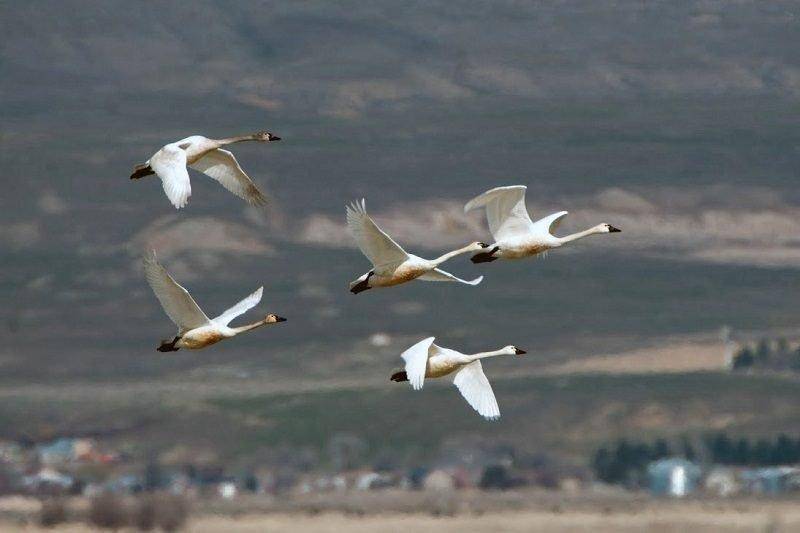DWR Press Release
Free viewing event on March 11
Ogden — Wild swans are winging their way through Utah right now.
Both tundra swans and trumpeter swans, which are more rarely seen, stop in Utah’s wetlands for critically needed rest and refueling during their annual spring migration. The migration takes the swans from wintering grounds in California to nesting sites in Canada and Alaska.
You can see the birds, and learn more about them, at this year’s Wild Swan Day.
Wild Swan Day – March 11
The Division of Wildlife Resources will host the event on March 11. Admission is free. The event will be held at two DWR waterfowl management areas: Salt Creek, west of Corinne, and Farmington Bay, west of Centerville.
Phil Douglass, regional conservation outreach manager for the DWR, says viewing will run from 9 a.m. to 3 p.m. He says the event gives people a great chance to see and hear thousands of tundra swans, and maybe even a few of the more rarely seen trumpeter swans.
“Each year,” he says, “a handful of trumpeter swans migrate through Utah with the tundra swans. This event gives people a chance to see and hear the differences between trumpeter and tundra swans. Both of the birds are magnificent; they’re awesome to see and hear.”
Douglass says spotting scopes and listening devices will be available at the sites, so you can get a close look at the swans and hear the differences in vocalizations between trumpeter and tundra swans. “If you have your own binoculars or a spotting scope, though,” he says, “please bring them. There are also numerous bird-sound apps that can help you identify swans and other birds by their sound.”
In addition to a thrilling viewing experience, knowledgeable and friendly people from the DWR and Wasatch Audubon will be available to answer your questions. “And, if you have a scout group that needs to talk to a conservation officer,” Douglass says, “this is the perfect place to do it.”
A preview of what you’ll see at the event is available in two videos on the DWR’s YouTube channel. You can view the swan videos at https://bit.ly/1Ap4fXE and https://bit.ly/1Js23Gb.
If you have questions about Wild Swan Day, call the DWR’s Northern Region office at 801-476-2740.
In addition to the two DWR viewing sites, the U.S. Fish and Wildlife Service is holding a swan viewing event on March 11 at the Bear River Migratory Bird Refuge. The refuge is west of Brigham City. To learn more about the event, visit www.fws.gov/refuge/bear_river_migratory_bird_refuge.
Directions
To reach the Compton’s Knoll viewing area at the Salt Creek WMA, travel west from Corinne on state Route 83 to 6800 West (Iowa String Road). Then, go north to 6800 North, and turn west.
The Farmington Bay WMA is at 1325 W. Glovers Lane in Farmington. To get there, take the Clark Lane exit from I-15, and travel west on Clark Lane to 1525 West. Turn south on 1525 West, and travel two miles to Glovers Lane, then turn left, and travel a half-mile to 1325 West, which is the entrance to the WMA.
Seeing swans on your own
If you can’t attend the March 11 event, you can still see swans, but Douglass encourages you to visit the marshes soon.
“The swan migration usually peaks in mid-March,” he says. “This year, we decided to hold the event a little earlier in the month. Weather is always the ‘wild card’ with wildlife viewing events, and good weather means good traveling conditions for migrating swans. But, even if some swans have moved through Utah by March 11, there will still be lots of other waterfowl to see. And the earlier date for the event should still give you a chance to see swans. Swan numbers are building right now.”
Douglass says the Salt Creek WMA is one of the best places in Utah to get a close look at swans. It’s also a likely spot to see and hear both trumpeter and tundra swans together.
“Last spring,” he says, “I was watching 2,500 tundra swans when suddenly I heard trumpeter swans. It took some time and determination, but I eventually found eight trumpeters among the tundra swans. Seeing both tundra and trumpeter swans was an amazing experience.”

